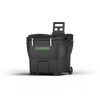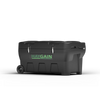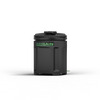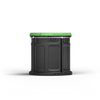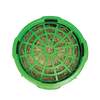Why worry about stable flooring?
Didn’t horses live for centuries before the invention of the ubiquitous rubber stable

mat? Of course they did, but back then they weren’t confined to stables for the greater part of each day. Until the advent of the car and delivery truck, horses were literally the horsepower that conveyed people and packages where they needed to go.
In the wild, mustangs travel more than 20 miles a day in search of food, water and shelter. Today, the average pleasure or performance horse that lives in a stable may get out for exercise once a day, or only a few times a week, and the duration of that exercise varies wildly.
For an animal that nature designed to be almost continually on the move, the modern horse’s stable-bound life presents real challenges. Movement not only builds and maintains muscle, keeps tendons and ligaments strong and supportive, increases blood flow throughout the horse’s entire system, and promotes efficient digestion and elimination – it provides a way for the horse to release tension, express emotions and interact socially.
Stable flooring for every purpose
For cushioning and stability, at home and away at shows, in trailers, grooming areas and tack rooms, stable flooring provides a wide range of benefits to the horse, from absorbing concussion to providing energy return with each step, as well as adding durability, traction and a level surface to the stable floor.

Horse housing can be a box stable, a barn or simple lean to. Regardless of grandeur or its lack, this is likely the place where your horse spends much of his time. More time = more influence on health and happiness.
Service areas in the barn can include tack rooms, feed rooms, wash bays, grooming stables, veterinary areas, and more. These should not be overlooked, especially as the grooms, horse owners, riders and trainers may be spending more time here than the horses do.
Show stabling can be quite sad, with uneven dirt floors, wet spots from the previous occupant, canvas walls with patches or even holes, and the list goes on. Suffice to say, bringing your own stable flooring, even if it is a royal pain you know where, can provide your horse with the environment he needs to be well-rested, fresh, and looking forward to his job.
Horse trailers are often the last place that good flooring is considered, much less installed. But consider this: If you are trailering for an hour or two to a one-day show before saddling up, warming up and showing, how much impact does that bumpy, swaying trailer ride have on your horse’s performance? Longer trailer rides to more distant shows are even more taxing on horses. Great flooring can help create great performances.
Stable flooring problems
When the wrong kind of flooring is underfoot in the stable, it can cause a world of problems.
- Holes and uneven surfaces can put undue strain on the horse’s legs, and can result in damage to tendons and ligaments.
- Damp, wet surfaces can grow bacteria, which off-gases ammonia, which damages the respiratory system – or it can grow mold, which can be even worse.
- Sandy soil can shift, and if enough is ingested, can cause sand colic.
- Hard flooring, whether highly-compacted native soil or hard rubber mats, can be a source of hock sores, hip sores and pastern sores, especially for thin-skinned horses.
- Rubber mats traditionally come in rectangular pieces, which can be further cut down to fit the exact dimensions of the horse’s stable. Urine can seep through the cracks to collect underneath the mat and breed bacteria which, in turn, off-gases ammonia fumes which are damaging to the lungs of horses as well as humans.

- Rubber mats over concrete only goes so far in improving the conditions under-hoof. Mats are not necessarily softer – some have been tested and found only 3% softer than concrete. And those that are softer are also more prone to faster damage and deterioration over time.
- Geotextile topcovers, as used in some stable flooring systems, can wear rather rapidly, and even tear – which opens up the system to the same bacteria-and-ammonia cycle described above.
- Crumb rubber-filled tubes used in some stable flooring systems does not provide a level and supportive surface for the horse to stand on, but instead opens the possibility for the horse to trip or to twist or tweak a joint, tendon or ligament.
Stable flooring questions
When you consider all of your choices, how do you decide? Let’s break it down, step by step, so you can choose the right stable flooring for your horse. First, think about your horse’s living situation.
Do you keep your horse at livery or at home? If your horse is at home, you can choose what you like best. However, if you are on a livery yard, you’ll need to consult with the yard manager to make sure your choice will work.
Is your horse stabled in a box stable with separate or attached turnout? Consider whether the box stable part of the equation should have one type of stable flooring and the area immediately outside the door another type of flooring.
Is your horse’s living space mostly indoors or outside? Does he nap indoors or out? You may notice that his habits change when your new stable flooring is in place.

Does drainage redirect standing water away from your horse’s barn? It’s important to whatever type of stable flooring system you choose, as even moderate rainfall can make horsekeeping chores difficult if runoff water is draining into your hay room or your horse’s stable.
Are you retrofitting new stable flooring into an older barn? Consult with your stable flooring company for any questions you may have. Ask them for tips on installation, recommendations for installers, and any other questions you may have. Ask them what problems other customers have had with installation so you won’t make the same mistakes.
How much time does your horse stand in his stable each day – or does he roam the fields for part of the day or night? Does he have any special considerations such as recurring laminitis, a recovery period after straining or tearing a tendon, or other physical conditions that need adaptation? Does your horse have any “stable warrior” behaviors such as weaving or pawing that will affect the stable flooring? Your horse’s size and weight as well as the type and size of his shoes can tell you a lot about how durable the stable floor needs to be.
Stable flooring solutions
There’s something for everyone, and everyone’s budget, when it comes to stable flooring. Let’s examine the pros and cons:
Traditional hard rubber mats
Pros: Available everywhere, relatively low cost, 4’x8’ size is easy to move.
Cons: Can curl at the corners if not installed correctly over a level surface, allows urine to escape through the cracks between mats and create a bacteria breeding ground underneath – the source of harmful ammonia odors.
Pebble-surfaced mats
Pros: Same as the traditional hard rubber mats, with additional nonslip property.
Cons: Same as the traditional hard rubber mats, and some mats of this type are not as thick so tend to wear out more rapidly.
Interlocking mats
Pros: Lightweight and easy to move, jigsaw puzzle shape to keep them in place.
Cons: Soft rubber makes these less durable than other rubber mats.
Geotextile topcover over crumb rubber pockets encased in geotextile
Pros: Provides more cushion than rubber mats, has a rubber permeated coating over the geotextile fabric.
Cons: Coating wears off to leave porous geotextile fabric which then absorbs urine and bacteria growth and ammonica off-gassing can take place inside the pockets.
ComfortStall® Orthopedic Sealed Flooring System
-
Pros: ComfortStall supports joint health. Improved movement, flexibility and hoof quality, because ComfortStall supports joints, tendons and ligaments – thanks to the therapeutic properties of its level surface that “springs” back with every step.
-
Pros: ComfortStall improves respiratory health. Stable air quality is greatly improved, because the sealed impermeable one-piece Ironclad™ Top Cover prevents urine from sneaking underneath to produce urea, bacteria and the ammonia fumes harmful to equine (and human) respiratory systems.
-
Pros: ComfortStall eliminates hock sores. Thanks to its non-slip, non-abrasive surface, horses can get up without scuffling. Their body weight sinks their hooves down into the padded floor, so they can lie down and get up with ease.
- Pros: ComfortStall improves quality of rest. Horses have been seen sleeping on bare ComfortStall flooring for hours at a time, getting their all-important REM sleep.

-
Pros: ComfortStall relieves horses suffering from sore feet and symptoms of laminitis. The padded flooring provides a comfortable and supportive cushion to stand on, and encourages them to lie down more and take the weight off their feet.
-
Pros: ComfortStall reduces the need for stable bandages. The ‘spring’ in its cushioned flooring massages the horse’s frogs, which stimulates blood circulation with every step.
-
Pros: ComfortStall provides recumbent whole-body support. Its orthopedic padded flooring system provides the needed ‘give’ under the hip, shoulder and pastern bones when the horse lies down and rises.
- Pros: ComfortStall provides thermal insulation. The cold and damp of concrete and packed-earth floors are problems no longer; neither is the heat. ComfortStall floors insulate from -70 to 175 degrees F.

-
Pros: ComfortStall requires less bedding. Because bedding is needed only to absorb urine, ComfortStall significantly reduces the cost of buying, cleaning and disposing of bedding.
- Pros: ComfortStall is a smart investment. Cost savings from using less bedding typically recover the cost of buying and installing ComfortStall within 6 months to a year.
When it’s time to look for stable flooring, look at all the details before making your choice. Your horse’s health and well being depend on it.
